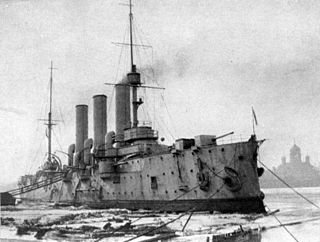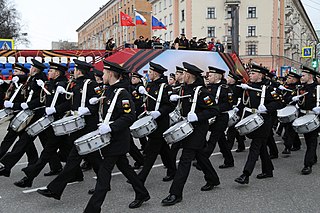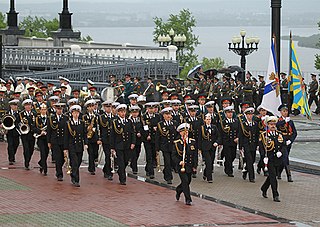
Soviet Naval Aviation was the naval aviation arm of the Soviet Navy.

The Azerbaijan Navy is the naval component of the Azerbaijani Armed Forces operating in the Caspian Sea.

The Soviet Banner of Victory was the banner raised by the Red Army soldiers on the Reichstag building in Berlin on 1 May 1945, the day after Adolf Hitler committed suicide. It was raised by three Soviet soldiers: Alexei Berest, Mikhail Yegorov, and Meliton Kantaria.

The Nakhimov Naval School or Nakhimov School is a form of military education for teenagers introduced in the Soviet Union and once also located in other cities. They are named after Imperial Russian admiral Pavel Nakhimov.

The Russian Navy ensign, also known as St. Andrew's flag, was the ensign of the Navy of the Russian Empire, and is the naval ensign of the Russian Federation since 1992, and the banner of the Navy of the Russian Federation since 2000.

The 2000 Moscow Victory Day Parade was held on 9 May 2000 to commemorate the 55th anniversary of the capitulation of Nazi Germany in 1945. The parade marks the Soviet Union's victory in the Great Patriotic War.

The Russian Baltic Fleet played an important role during the October Revolution and Russian Civil War. During the October Revolution the sailors of the Baltic Fleet were among the most ardent supporters of Bolsheviks, and formed an elite among Red military forces. Some ships of the fleet took part in the Russian Civil War, notably by clashing with the British navy operating in the Baltic as part of intervention forces. Over the years, however, the relations of the Baltic Fleet sailors with the Bolshevik regime soured, and they eventually rebelled against the Soviet government in the Kronstadt rebellion in 1921, but were defeated, and the Fleet de facto ceased to exist as an active military unit.

The Russian Hydrographic Service, full current official name Department of Navigation and Oceanography of the Ministry of Defence of the Russian Federation, is Russia's hydrographic office, with responsibility to facilitate navigation, performing hydrographic surveys and publishing nautical charts.

The Military Band Service of the Armed Forces of the Russian Federation serves as the official service of military bands in active service within the Russian Armed Forces and formerly the Soviet Armed Forces. It is part of the Military Band Service Directorate of the General Staff of the Armed Forces of the Russian Federation.

Day of the Russian Navy is national holiday in the Russian Federation and a senior holiday in the Russian Armed Forces. The day honors the sailors in units of the Russian Navy and its specialized arms. It is celebrated annually, on the last Sunday of July.

The Murmansk Nakhimov Naval School is one of five Nakhimov Naval Schools in Russia. The current head of the school is Vice Admiral Alexei Maksimchuk.

Russian military bands fall under the jurisdiction of the Military Band Service of the Armed Forces of Russia, which is the official music service for the Russian Armed Forces, and led by the Senior Director of Music, a billet of an officer with the rank of a Colonel or a general officer. There are currently between 200 and 300 military bands in the Russian Armed Forces that span across the military as well as all uniformed services in the country. Unlike most western nations, the Armed Forces does not maintain any bands composed of volunteering civilian musicians, as all bands, active or reserve, are manned by graduates of the military music training centers stationed anywhere in the country, as well as of civilian conservatories. While choirs may be attached to military bands, individual staff choirs do not exist in the Russian Armed Forces, since they have attached instrumental ensembles or orchestras. As of 2009, all military musicians are paid around 13,000 rubles ($169.65) for their service in the Armed Forces and other uniformed organizations.

Nikolai Mikhailovich Maksimov is a retired officer of the Russian Navy. He currently holds the rank of admiral in the reserve, and has most recently been head of the Navy Shipbuilding and Weapons Research Institute.
Yuri Fedorovich Rall was an officer of the Imperial Russian and Soviet Navies. He saw action during the First and Second World Wars, and rose to the rank of vice-admiral.

The Makarov Pacific Higher Naval School is one of the Russian Navy's two higher educational institutions under the Ministry of Defense of Russia, with this school being located in Vladivostok in Eastern Russia, the only naval educational institution in this region. It serves as an naval officer commissioning school for officers in the Pacific Fleet. It is named after the accomplished Russian oceanographer and commander of the Imperial Russian Navy, Vice-Admiral Stepan Makarov.

The Nakhimov Naval School in Saint Petersburg is a military boarding school of the Russian Navy.

The Culture of the Russian Armed Forces is widely varied, but unique amongst the branches of the armed forces, and shared with the other uniformed organizations within Russia. Military culture is the most important component of military life. The major cultural events held by the Russian military are primarily aimed at strengthening esprit de corps as well as advancing the historical traditions of the Armed Forces of Russia. The Ministry of Defence of Russia regularly holds cultural events at various levels. The central cultural institutions of the Ministry of Defense of the Russian Federation are actively working in all military districts.
Viktor Konstantinovich Vasilyev was an officer of the Imperial Russian and Soviet navies. He rose to the rank of rear-admiral.


























